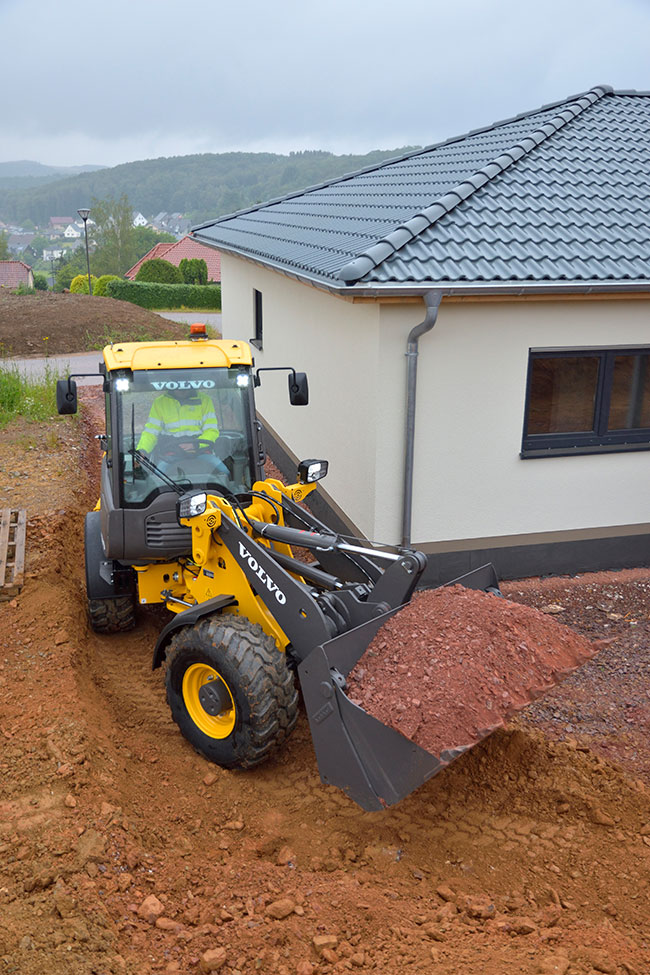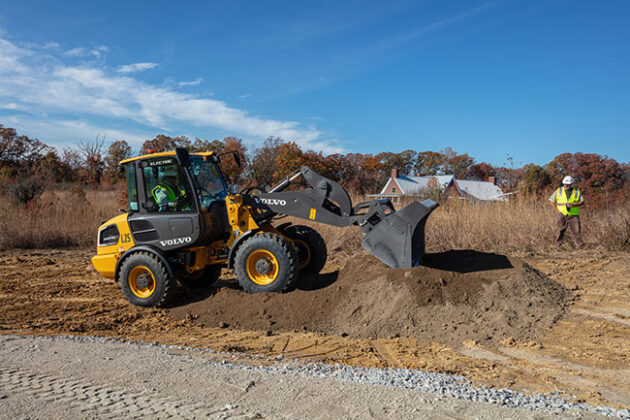
Features
Autonomous Equipment & Battery Power
Eco-Friendly Equipment
Technology
Electric and battery power going bigger in turf industry machinery
Five reasons to consider electric-powered equipment in landscaping, golf and parks projects
September 3, 2023 By Lars Arnold, product manager, Volvo Construction
 An electric machine is used to grade land in a new residential neighbourhood, providing a lower noise level without harmful emissions.
Photo credit: Volvo Construction Equipment
An electric machine is used to grade land in a new residential neighbourhood, providing a lower noise level without harmful emissions.
Photo credit: Volvo Construction Equipment Battery-powered tools and equipment are not new to turf pros, but until recently, “electric” typically meant the smaller stuff. Now, machines often thought of as diesel-dependent construction equipment are electrifying a path into this segment – and they’re exceeding expectations.
Smaller heavy equipment like mini excavators and compact wheel loaders are going electric and gaining momentum. So, why should you consider adding electric machines to your arsenal? Here are five great reasons.
The power hasn’t diminished
Compact excavators and wheel loaders are great for grading, earthmoving, digging, loading material and much more. I’ve seen landscapers, golf superintendents and parks and rec crews get very creative in how they use this equipment, and they depend on that diesel power to get bigger jobs done
So, let’s address the elephant in the room: power. Some people think an electric machine must be inferior to a diesel machine in this regard, but I can assure you that’s not the case. In fact, in addition to matching or exceeding the power of diesel models, electric equipment offers other advantages.
One of the most popular traits is that an electric motor provides instant torque as soon as you start running the machine. There’s no feeling of a slight delay, which can happen with diesel equipment. And in most cases, these machines have the same (or nearly the same) specs as their conventional counterparts.
Bottom line: You won’t experience a drop in performance. In fact, I frequently hear from users who are pleasantly surprised that an electric machine matches up to and actually feels stronger and more powerful than diesel.
Charging is simpler than it seems
First, many people in the turfgrass industry have used electric equipment like mowers and tools, so you’re likely more experienced with this than a construction contractor is. Charging a machine like a compact excavator or wheel loader is not drastically different.
And if you are new to electric, you should know that you can use the same outlets found in most garages and homes. You can also go with a different setup. Think of it like filling your car with gasoline. Would you rather do it with a gas can or a fuel pump? The same logic applies for electric: The more power you can put into your machine, the faster it will charge.
The best setup is a 240-volt Level 2 AC-charging outlet that utilizes an SAE J1772 charging adapter or J plug. Don’t let the terminology intimidate you – this is the same setup recommended for electric cars and many household appliances, and it’s easy to install if you don’t already have it. You could also use a regular 120-volt outlet, but charging will take quite a bit longer. There are also options like off-board DC fast chargers and solar-powered chargers that are getting better and more prevalent every day.
Batteries often last a full shift
Compact equipment can be used in so many ways, and the differences can affect how long the batteries last. I recommend charging whenever you have a pause in your workday. I’ve seen customers who need a quick charge at lunch doing heavier work like cutting and grading. Meanwhile, customers who use the machine intermittently or in lighter applications have found that a charge can last them all day.
To give you an idea, electric machines can often work for four to six hours – and keep in mind that given the stops and starts of most work, it’s rare for a machine to actually be in operation for that long. Electric machines also include an automatic shutdown feature, so when an operator stops running the machine, the electric motor turns off almost immediately. And to get working again, the electric motor turns on instantly and provides immediate power.
With diesel equipment, operating time is defined by the engine runtime, and a lot of those hours are counted while the machine is idle. So, 10,000 hours on a diesel machine might only equate to 6,000 or 7,000 hours on a comparable electric machine. These saved hours lower operating costs, improve total cost of ownership and boost resale value.
Maintenance is easier; operating is nicer
Another major advantage of electric equipment is that diesel exhaust fluid and filters are not needed. Essentially, the only supplies required are grease and hydraulic oil. This is much different than a conventional machine that requires fluid, filter and component checks as often as every day, with additional cyclical preventive fluid and filter maintenance. In general, the lifetime of battery-electric components should be equal to or better than that of the diesel engine on a conventional machine.
Workers will also love electric equipment because they can easily talk over the lower noise and vibration, improving jobsite communication and making their day less exhausting. People are shocked at how quiet these machines can be!

Electric and battery-powered machinery is no longer confined to smaller-sized equipment. It is now powering heavier equipment and providing the same eco-friendly attributes.
Photo credit: Volvo Construction Equipment
Boost your long-term bottom line
More governments are adopting clean air policies, and private companies are setting their own sustainability goals, so if you’re looking to make an easy-but-significant impact, electric equipment is a win-win. And of course, a lot of landscaping, golf and municipal work occurs in areas where noise and emissions are frowned upon or even restricted. The ability to get more work done (compared with handheld tools) with less noise and zero emissions is a huge advantage that can win jobs or simplify existing projects.
My biggest advice when it comes to the numbers: Don’t get hung up on the purchase price. The total cost of ownership helps make up for a higher-priced machine, and your dealer may be able to help you find grants or incentives.
Our conservative estimate is that maintenance costs will be 35 per cent lower and you’ll see up to a 45 per cent reduction in hours on the operating hour meter, which reduces wear and tear and preserves residual value. Plus, there’s the value of being able to do work you couldn’t do before.
Electric excavators and wheel loaders are also starting to be stocked at rental houses, which is nice if you want to get more comfortable with this new technology before fully diving in. Then you can also rent various types of charging equipment to see what works best for your specific operation.
The proof is in the performance
If you’re still not convinced, maybe a few customer examples will help.
An electric compact excavator and an electric compact wheel loader were used to build a trail at a national wildlife refuge in Maryland. As you can imagine, the quiet operation was less of a disturbance to the protected animals living in the area, and the lack of emissions was safer for the natural environment.
The same machines also performed well on a property development project in California, which included reshaping land, grading for stormwater control and relocating soil stockpiles. The operators noted machine performance that matched what they would expect from a diesel model but with zero emissions.
A third – and unexpected – example was at the Toronto Zoo. The team there used electric machinery to do some landscaping work inside a bison enclosure, which usually agitates the animals to the point that they begin to cry out. Because the machine was so quiet, the operator was able to work for three hours with no irritation to the bison.
Given that turf pros often work in green environments and populated areas, electric machines’ lack of emissions and much lower noise levels give them an advantage when bidding on a project and keeping customers and neighbours happy.
So, before you write off their power or doubt their momentum in the market, give electric heavy machines a closer look. I think you’ll be pleasantly surprised.
This article is part of the Equipment Week.
This article is part of the Earth Week.
Print this page